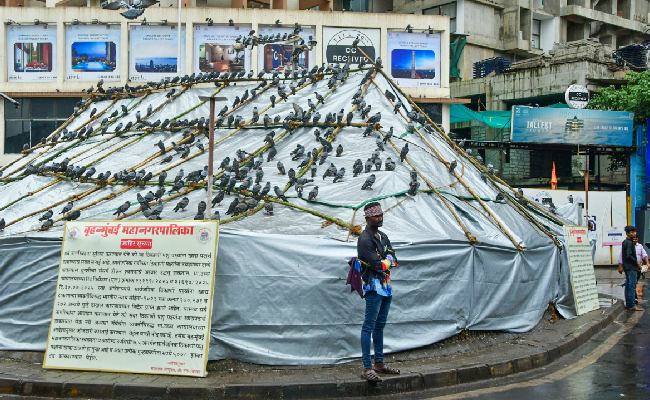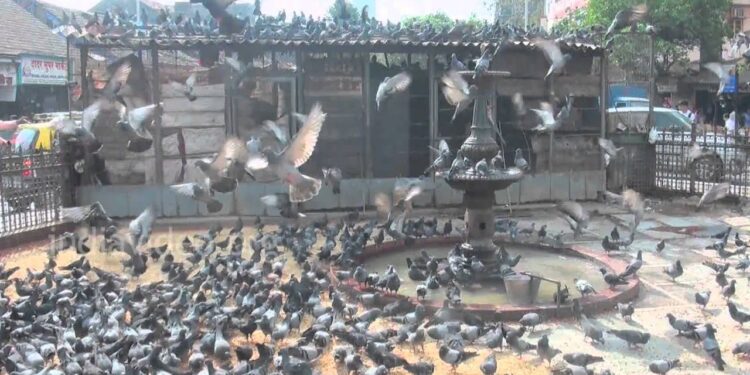Mumbai’s Kabutarkhana protest escalates as authorities remove tarpaulin shelters; incident sparks widespread criticism and draws condemnation from a state minister.”

Tensions Escalate as Dadar Kabutarkhana Cover Is Torn Down, Minister Lodha Voices Strong Disapproval
Mumbai, August 6, 2025 — At the iconic Dadar Kabutarkhana, tensions reached a boiling point on Wednesday morning when members of the Jain community forcibly removed a tarpaulin cover installed by the Brihanmumbai Municipal Corporation (BMC) to enforce a ban on pigeon feeding. The act sparked widespread disruption, prompting condemnation from Maharashtra Suburban Guardian Minister Mangal Prabhat Lodha, who described the action as “wrong and condemnable.”
Background: A Large-Scale Crackdown
The BMC’s decision to seal off the Dadar feeding zone with plastic sheets and bamboo framework came in compliance with a Bombay High Court directive issued on July 30. The court had ordered the closure of all 51 kabutarkhanas in Mumbai, citing public health concerns stemming from pigeon droppings and potential respiratory illnesses. Authorities were also instructed to register FIRs against individuals violating the ban under public health-related provisions of the Bharatiya Nyaya Sanhita.
Between July 13 and August 3, the BMC handed fines to 142 people—51 violations occurred at Dadar alone—totaling ₹68,700. Each infraction carried a typical ₹500 penalty.
The Protest: Faith Meets Enforcement
Dozens of Jain community members assembled at Dadar Kabutarkhana, viewing the feeding of pigeons as an integral religious and ethical duty. In a dramatic turn, protesters removed both the tarpaulin and the temporary bamboo enclosure, escalating into confrontations with police who were deployed to restore order.
The protest, largely composed of youth and women, was marked by passionate slogans and chants. Some participants claimed that pigeons were dying from starvation and threatened to intensify action if authorities didn’t relent.
Political Intervention: Calls for Balance
Minister Lodha promptly visited the site after the altercation. He condemned the removal of the cover as “condemnable” and underscored the need for peaceful protest. While expressing sympathy for the community’s suffering, Lodha reaffirmed that the BMC would consider “appropriate” action against individuals involved in the disturbance. He also noted that the local Jain temple trust denied any direct involvement in instigating the protest, stating that outsiders may have played a role.
In his letter to BMC Commissioner Bhushan Gagrani, Lodha urged finding a middle ground—one that respects religious sentiments while complying with public health imperatives. He proposed alternative pigeon-feeding areas in places like the Bandra-Kurla Complex, Aarey Colony, and Sanjay Gandhi National Park, where supervise feeding zones could be established.
State Leaders Step In
Chief Minister Devendra Fadnavis called an urgent meeting on the issue, acknowledging that the swift and sweeping action by municipal authorities may have been unwise. He emphasized the need for “regulated feeding” with strict organisational support until more sustainable accommodation can be arranged. Fadnavis suggested formulating a comprehensive policy, including a scientific study to assess pigeon-related health risks and explore solutions for waste management.
The Jain Community’s Response
Community leaders argue that feeding pigeons is a sacred tradition tied to their belief system. They assert that abrupt bans have led to widespread pigeon deaths due to starvation, and that the sudden enforcement infringes upon religious and cultural freedoms protected by Article 51(A)(g) of the Constitution, which calls for compassion toward all living beings.
Jain muni Nilesh Chandra Vijay and other spiritual leaders announced a peace protest scheduled for August 10 at Dadar Kabutarkhana. Should the Bombay High Court issue an unfavourable verdict on August 7, they plan to begin an indefinite hunger strike. Organisers expect participation from residents across South Mumbai, including from Dadar, Vile Parle, and beyond.
Public Health Concerns and Broader Implications
Medical institutions like KEM Hospital have submitted findings to the High Court highlighting risks such as hypersensitivity pneumonitis (often called “pigeon lung”) linked to pigeon droppings and feathers. Authorities argue that mass congregation of pigeons in public spaces directly impacts air quality and poses respiratory hazards—particularly to vulnerable groups such as children, the elderly, and those with preexisting conditions.
What Lies Ahead
The final hearing on compliance is set for August 7, when the Bombay High Court is expected to review medical evidence and enforcement data submitted by the BMC and other agencies.
As debates rage between cultural tradition and public health, the government appears intent on charting a middle path—potentially formalising designated feeding zones under civic supervision, while maintaining enforcement at existing kabutarkhanas until viable alternatives are in place.
Minister Lodha’s firm rebuke of the protest—calling it “condemnable”—signals that authorities will not tolerate civil disorder, even as they face pressure to accommodate religious sentiment. At stake is not only the fate of Mumbai’s pigeons but also how democratic India negotiates tradition, law, and public welfare in its urban core.















 Categories
Categories









